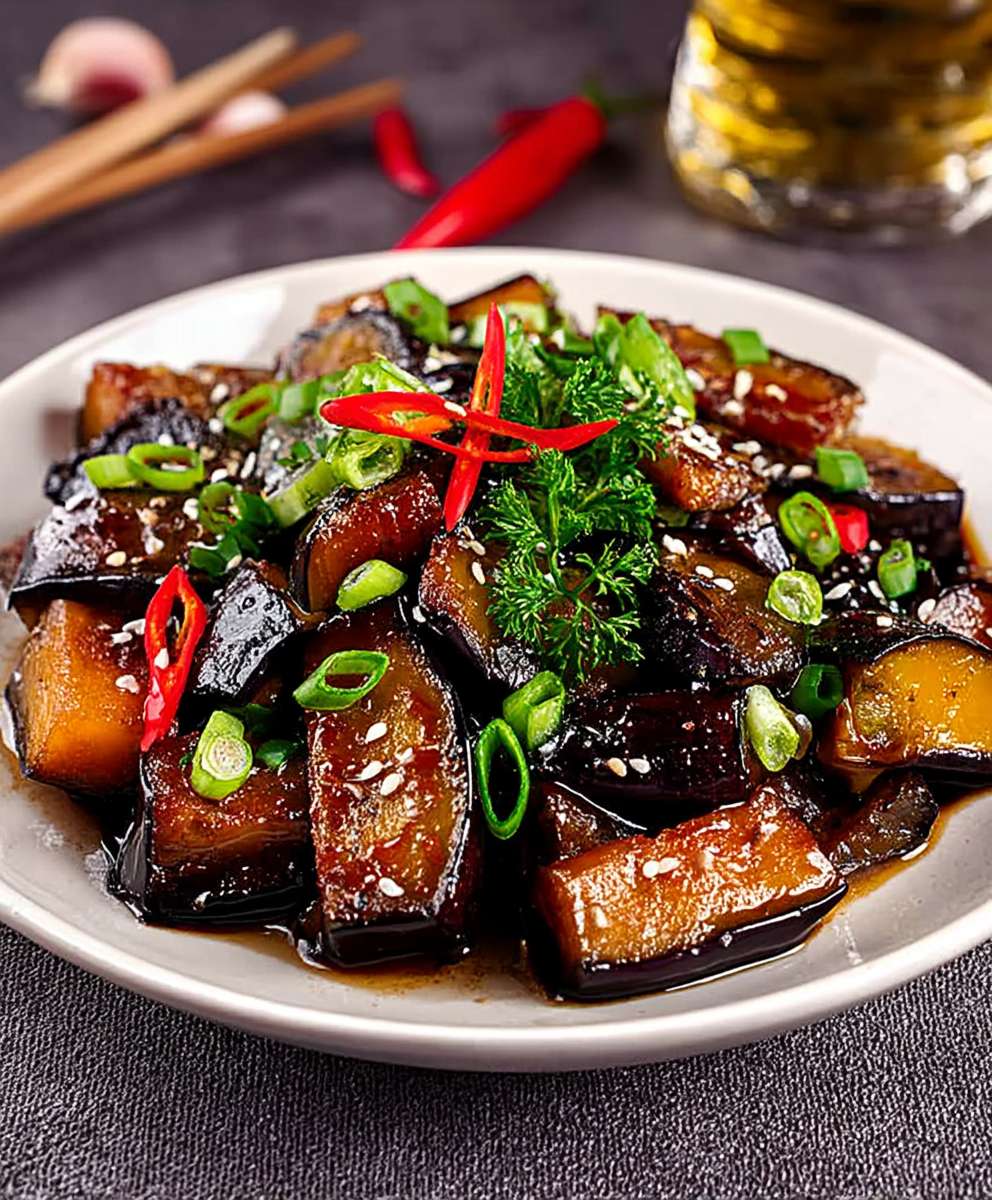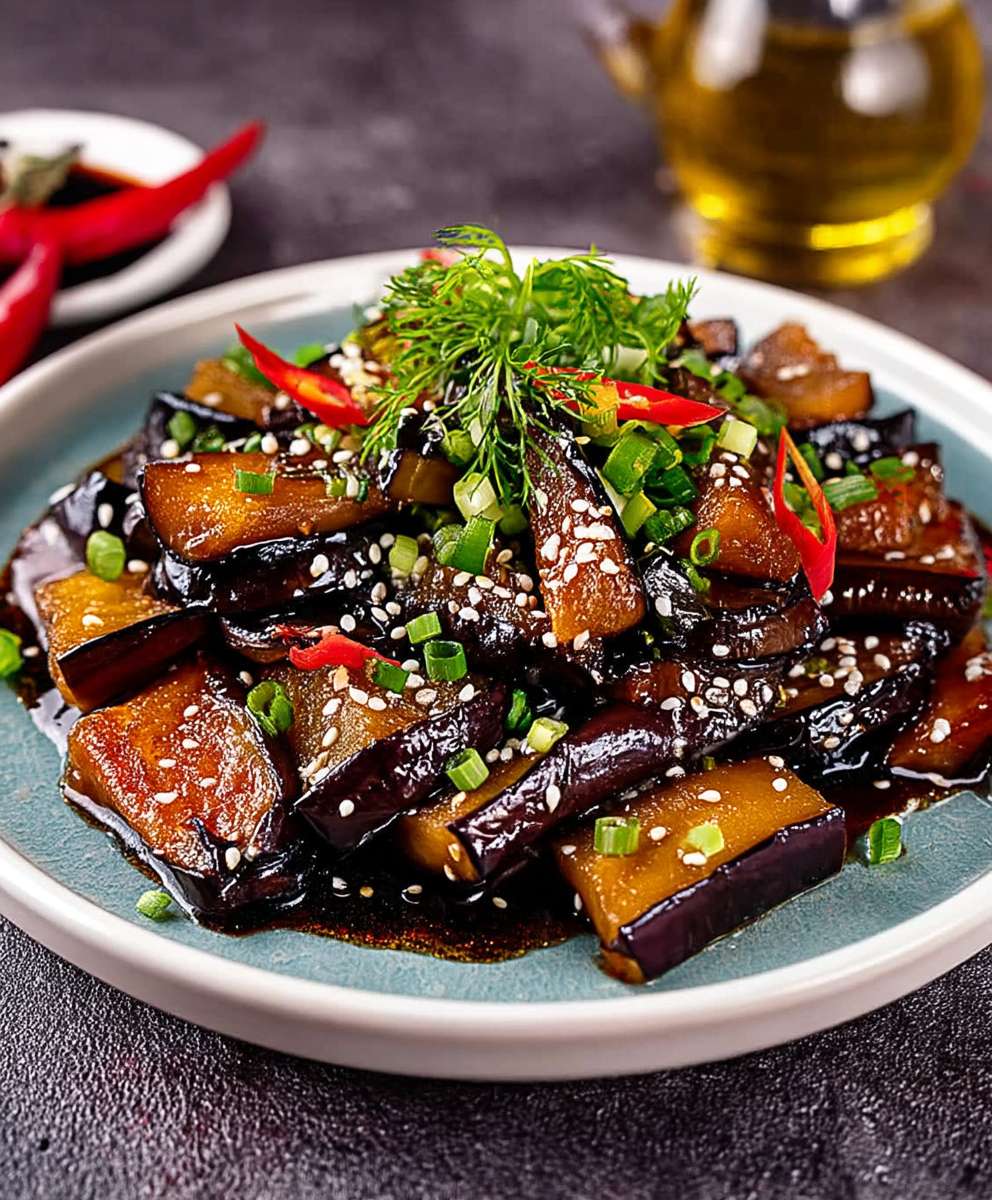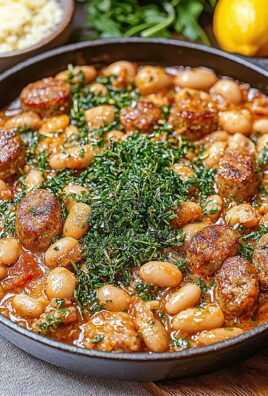Asian eggplant dishes are a culinary adventure waiting to happen! Have you ever craved a dish that’s both incredibly flavorful and surprisingly healthy? One that transports you to the bustling streets of Asia with every single bite? Then you’re in the right place. I’m about to share a recipe that will transform the humble eggplant into a star.
Eggplant, also known as aubergine, has a rich history in Asian cuisine, dating back centuries. It’s believed to have originated in India and gradually spread throughout the continent, becoming a staple ingredient in countless regional dishes. From the spicy stir-fries of Sichuan to the delicate curries of Thailand, eggplant has proven its versatility and adaptability.
What makes Asian eggplant dishes so irresistible? It’s the perfect combination of textures and tastes. The eggplant, when cooked correctly, becomes incredibly tender and almost melts in your mouth. It soaks up all the delicious sauces and spices, creating a symphony of flavors that will tantalize your taste buds. People love it because it’s a fantastic vegetarian option that’s both satisfying and nutritious. Plus, many Asian eggplant recipes are surprisingly quick and easy to prepare, making them perfect for busy weeknights. Get ready to discover your new favorite way to enjoy this amazing vegetable!
Ingredients:
- 2 large Asian eggplants (about 1.5 pounds total)
- 2 tablespoons vegetable oil
- 1 medium yellow onion, thinly sliced
- 3 cloves garlic, minced
- 1 inch ginger, peeled and minced
- 1 red bell pepper, seeded and sliced
- 1 green bell pepper, seeded and sliced
- 1/4 cup soy sauce
- 2 tablespoons rice vinegar
- 1 tablespoon sesame oil
- 1 tablespoon cornstarch
- 1 tablespoon brown sugar
- 1 teaspoon chili garlic sauce (or more, to taste)
- 1/4 cup water
- 2 green onions, thinly sliced, for garnish
- 1 tablespoon sesame seeds, for garnish
- Cooked rice, for serving
Preparing the Eggplant:
Okay, let’s get started! The eggplant is the star of the show, so we need to treat it right. Asian eggplants are great because they’re tender and cook quickly, but any eggplant will work.
- Slice the Eggplant: First, wash the eggplants thoroughly. Then, trim off the stem end. Now, slice the eggplants into 1/2-inch thick rounds. If the rounds are very large, you can halve or quarter them. We want bite-sized pieces that will cook evenly.
- Salt the Eggplant (Optional but Recommended): This step helps to draw out excess moisture from the eggplant, which will prevent it from becoming soggy when cooked. Place the eggplant slices in a colander and sprinkle them generously with salt. Toss them gently to ensure they’re evenly coated. Let them sit for about 30 minutes. You’ll notice moisture beading up on the surface.
- Rinse and Dry the Eggplant: After 30 minutes, rinse the eggplant slices thoroughly under cold water to remove the salt. Then, gently squeeze out any excess water. Pat them dry with paper towels. This step is crucial for achieving a nice sear on the eggplant.
Making the Sauce:
The sauce is where all the magic happens! This sweet, savory, and slightly spicy sauce perfectly complements the eggplant.
- Combine the Sauce Ingredients: In a small bowl, whisk together the soy sauce, rice vinegar, sesame oil, cornstarch, brown sugar, chili garlic sauce, and water. Make sure the cornstarch is fully dissolved to prevent lumps in the sauce. Taste the sauce and adjust the seasonings to your liking. If you prefer a sweeter sauce, add a little more brown sugar. For more heat, add more chili garlic sauce.
- Set Aside: Once the sauce is well combined, set it aside. We’ll use it later to coat the eggplant and vegetables.
Stir-Frying the Vegetables:
Now, let’s get those veggies nice and tender-crisp!
- Heat the Oil: Heat the vegetable oil in a large wok or skillet over medium-high heat. Make sure the wok is hot before adding the oil.
- Sauté the Onion: Add the sliced onion to the wok and sauté for about 2-3 minutes, or until softened and slightly translucent. Stir frequently to prevent burning.
- Add Garlic and Ginger: Add the minced garlic and ginger to the wok and sauté for about 30 seconds, or until fragrant. Be careful not to burn the garlic, as it can become bitter.
- Add Bell Peppers: Add the sliced red and green bell peppers to the wok and stir-fry for about 3-4 minutes, or until they are tender-crisp.
- Remove Vegetables: Remove the vegetables from the wok and set aside. We’ll add them back in later.
Cooking the Eggplant:
This is where the eggplant gets its delicious color and texture.
- Add More Oil (If Needed): If the wok seems dry, add a little more vegetable oil.
- Sear the Eggplant: Add the eggplant slices to the wok in a single layer. You may need to work in batches to avoid overcrowding the wok. Sear the eggplant for about 2-3 minutes per side, or until it is golden brown and slightly softened. The goal is to get a nice sear on the eggplant without completely cooking it through.
- Remove Eggplant: Remove the seared eggplant from the wok and set aside.
Combining and Simmering:
Time to bring everything together and let the flavors meld!
- Return Vegetables to Wok: Return the sautéed onion, garlic, ginger, and bell peppers to the wok.
- Pour in the Sauce: Pour the prepared sauce over the vegetables. Stir well to coat everything evenly.
- Simmer the Sauce: Bring the sauce to a simmer and cook for about 1-2 minutes, or until it has thickened slightly. Stir constantly to prevent the sauce from sticking to the bottom of the wok.
- Add Eggplant Back In: Add the seared eggplant back to the wok. Gently toss to coat the eggplant with the sauce.
- Simmer Together: Simmer for another 2-3 minutes, or until the eggplant is tender and the sauce has thickened to your desired consistency. Be careful not to overcook the eggplant, as it can become mushy.
Serving:
Almost there! Just a few finishing touches and it’s ready to enjoy.
- Garnish: Garnish the eggplant with sliced green onions and sesame seeds.
- Serve: Serve the Asian eggplant hot over cooked rice. The sauce is delicious spooned over the rice.
Tips and Variations:
- Protein: Feel free to add protein to this dish. Tofu, chicken, or shrimp would all be great additions. Simply cook the protein separately and add it to the wok along with the vegetables.
- Vegetables: You can customize the vegetables to your liking. Broccoli, carrots, or mushrooms would all be delicious additions.
- Spice Level: Adjust the amount of chili garlic sauce to control the spice level. If you don’t have chili garlic sauce, you can use a pinch of red pepper flakes instead.
- Sweetness: Adjust the amount of brown sugar to control the sweetness. You can also use honey or maple syrup as a substitute.
- Gluten-Free: To make this dish gluten-free, use tamari instead of soy sauce.
Enjoy!
I hope you enjoy this delicious and easy Asian eggplant recipe! It’s a great way to use up those summer eggplants and it’s sure to become a family favorite.

Conclusion:
This isn’t just another eggplant recipe; it’s a culinary adventure waiting to happen! From the tantalizing aroma that fills your kitchen to the explosion of flavors on your palate, this Asian eggplant dish is guaranteed to become a new favorite. The combination of tender, melt-in-your-mouth eggplant with the savory-sweet sauce is simply irresistible. It’s a symphony of textures and tastes that will leave you craving more.
But what truly makes this recipe a must-try is its versatility. Looking for a complete vegetarian meal? Serve it over a bed of fluffy jasmine rice or quinoa. Want to add some protein? It pairs perfectly with grilled chicken, shrimp, or tofu. For a lighter option, try serving it alongside a fresh cucumber salad or some steamed bok choy. The possibilities are endless!
And speaking of possibilities, don’t be afraid to experiment with variations! If you’re a spice lover, add a pinch of red pepper flakes or a dash of sriracha to the sauce for an extra kick. For a richer flavor, try using dark soy sauce instead of light soy sauce. If you’re short on time, you can even use pre-cut eggplant from the grocery store. The key is to have fun and make it your own!
Serving Suggestions and Variations:
* Rice or Quinoa Bowl: Serve over your favorite grain for a complete and satisfying meal.
* Protein Power: Add grilled chicken, shrimp, or tofu for extra protein.
* Spice It Up: Add red pepper flakes or sriracha for a fiery kick.
* Rich Flavor: Use dark soy sauce for a deeper, more intense flavor.
* Quick & Easy: Use pre-cut eggplant to save time.
* Vegetable Medley: Add other vegetables like bell peppers, onions, or mushrooms to the stir-fry.
* Noodle Delight: Toss with your favorite Asian noodles for a delicious noodle dish.
* Peanut Power: Sprinkle with chopped peanuts for added crunch and flavor.
* Sesame Seeds: Garnish with sesame seeds for a nutty aroma and visual appeal.
* Ginger Boost: Add more fresh ginger for a bolder, more aromatic flavor.
I truly believe that this recipe will become a staple in your kitchen. It’s easy to make, incredibly delicious, and endlessly adaptable to your own tastes and preferences. It’s the perfect dish for a weeknight dinner, a weekend gathering, or any occasion in between.
So, what are you waiting for? Grab your ingredients, put on your apron, and get ready to create some culinary magic! I’m confident that you’ll love this Asian eggplant dish as much as I do.
And most importantly, I want to hear about your experience! Did you try the recipe? What variations did you make? What did you think? Share your photos and comments in the section below. I can’t wait to see what you create! Happy cooking! Let me know if you have any questions, and I’ll do my best to help. I am excited to see your creations!
Asian Eggplant Dishes: Delicious Recipes and Cooking Tips
Savory and slightly spicy Asian eggplant stir-fry with tender-crisp vegetables in a delicious sweet and savory sauce, served over rice.
Ingredients
- 2 large Asian eggplants (about 1.5 pounds total)
- 2 tablespoons vegetable oil
- 1 medium yellow onion, thinly sliced
- 3 cloves garlic, minced
- 1 inch ginger, peeled and minced
- 1 red bell pepper, seeded and sliced
- 1 green bell pepper, seeded and sliced
- 1/4 cup soy sauce
- 2 tablespoons rice vinegar
- 1 tablespoon sesame oil
- 1 tablespoon cornstarch
- 1 tablespoon brown sugar
- 1 teaspoon chili garlic sauce (or more, to taste)
- 1/4 cup water
- 2 green onions, thinly sliced, for garnish
- 1 tablespoon sesame seeds, for garnish
- Cooked rice, for serving
Instructions
- Prepare the Eggplant: Wash eggplants, trim stems, and slice into 1/2-inch thick rounds.
- Salt the Eggplant (Optional): Place eggplant in a colander, sprinkle with salt, and let sit for 30 minutes to draw out moisture.
- Rinse and Dry: Rinse eggplant thoroughly under cold water to remove salt. Squeeze out excess water and pat dry with paper towels.
- Make the Sauce: In a small bowl, whisk together soy sauce, rice vinegar, sesame oil, cornstarch, brown sugar, chili garlic sauce, and water until smooth. Set aside.
- Stir-Fry Vegetables: Heat vegetable oil in a wok or skillet over medium-high heat.
- Sauté Onion: Add sliced onion and sauté for 2-3 minutes until softened.
- Add Garlic and Ginger: Add minced garlic and ginger and sauté for 30 seconds until fragrant.
- Add Bell Peppers: Add sliced red and green bell peppers and stir-fry for 3-4 minutes until tender-crisp.
- Remove Vegetables: Remove vegetables from the wok and set aside.
- Sear Eggplant: Add more oil to the wok if needed. Add eggplant slices in a single layer and sear for 2-3 minutes per side until golden brown and slightly softened. Work in batches if necessary.
- Remove Eggplant: Remove seared eggplant from the wok and set aside.
- Combine and Simmer: Return sautéed onion, garlic, ginger, and bell peppers to the wok.
- Pour in Sauce: Pour the prepared sauce over the vegetables and stir well to coat.
- Simmer Sauce: Bring the sauce to a simmer and cook for 1-2 minutes until thickened, stirring constantly.
- Add Eggplant: Add the seared eggplant back to the wok and gently toss to coat with the sauce.
- Simmer Together: Simmer for another 2-3 minutes, or until the eggplant is tender and the sauce has thickened to your desired consistency.
- Garnish and Serve: Garnish with sliced green onions and sesame seeds. Serve hot over cooked rice.
Notes
- Protein: Add tofu, chicken, or shrimp. Cook separately and add with the vegetables.
- Vegetables: Customize with broccoli, carrots, or mushrooms.
- Spice Level: Adjust chili garlic sauce to taste. Use red pepper flakes if you don’t have chili garlic sauce.
- Sweetness: Adjust brown sugar to taste. Use honey or maple syrup as a substitute.
- Gluten-Free: Use tamari instead of soy sauce.






Leave a Comment